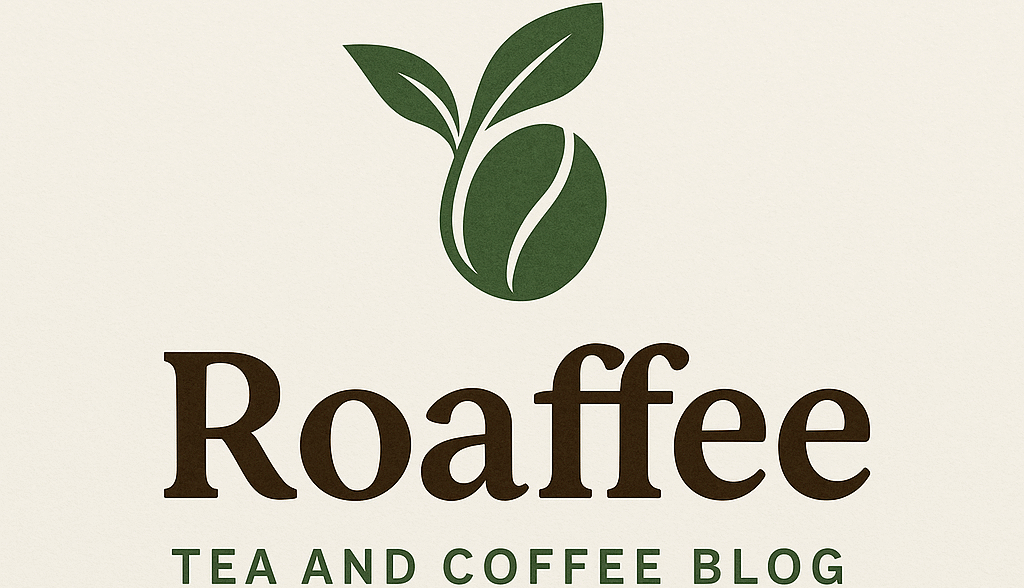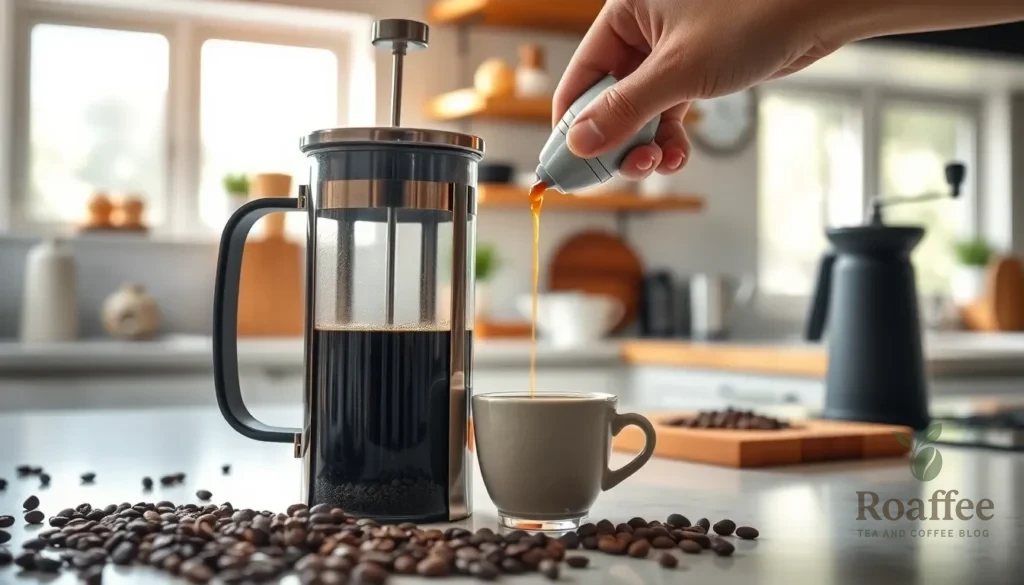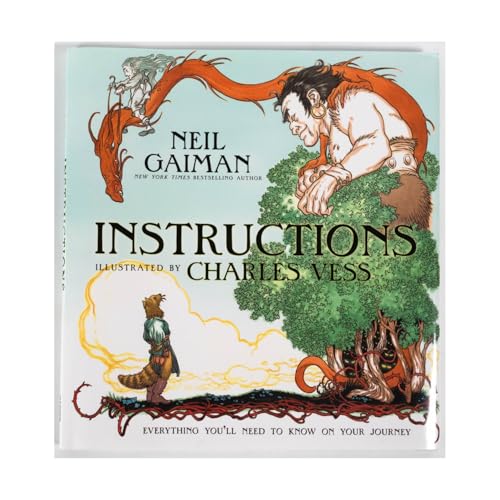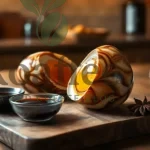French press coffee delivers rich, full-bodied flavor that’ll transform your morning routine. This classic brewing method extracts maximum oils and sediments from coffee grounds, creating a robust cup that’s impossible to replicate with other techniques. We’re talking about pure, unadulterated coffee that’s been perfected over decades.
The beauty of French press lies in its simplicity. You don’t need expensive equipment or complicated gadgets – just coarsely ground beans, hot water, and a few minutes of patience. It’s the brewing method that coffee purists swear by, and once you master the technique, you’ll understand why.
We’ll walk you through every step of creating the perfect French press coffee, from selecting the right grind size to timing your brew for optimal extraction. Whether you’re a coffee novice or looking to refine your technique, this guide will help you unlock the full potential of your beans and create café-quality coffee at home.
What You’ll Need
Making exceptional French press coffee requires minimal equipment and high-quality ingredients. We’ll walk you through the essential tools and materials needed to brew consistently delicious results.
French Press Equipment
French Press Maker
We recommend a glass or stainless steel French press for optimal heat retention and durability. A 34-ounce capacity works perfectly for serving 2-4 people and allows proper coffee-to-water ratios.
Coffee Grinder
A burr grinder produces the most consistent coarse grounds essential for French press brewing. Blade grinders work in a pinch but create uneven particle sizes that can lead to over-extraction.
Kitchen Scale
Digital scales ensure precise measurements for repeatable results. We measure both coffee beans and water by weight rather than volume for accuracy.
Timer
A simple kitchen timer or smartphone helps track the crucial 4-minute steeping time. Consistent timing makes the difference between good and exceptional coffee.
Wooden Spoon
A wooden stirring spoon prevents scratching your French press while ensuring even saturation of the coffee grounds.
Coffee and Water Requirements
Coffee Beans
Fresh whole beans roasted within 2-4 weeks deliver the best flavor. We prefer medium to dark roasts that complement the French press brewing method’s full-bodied extraction.
Water Quality
Filtered water removes chlorine and impurities that interfere with coffee taste. The ideal water temperature ranges between 195-205°F for proper extraction without burning the grounds.
Ratios and Measurements
The golden ratio uses 1:15 coffee to water by weight. For a standard 34-ounce French press we use 56 grams of coffee beans to 840 grams of water.
| Component | Amount | Notes |
|---|---|---|
| Coffee beans | 56g | Coarsely ground |
| Water | 840g | Filtered, 195-205°F |
| Brew time | 4 minutes | Consistent timing |
| Grind size | Coarse | Sea salt consistency |
Ingredients
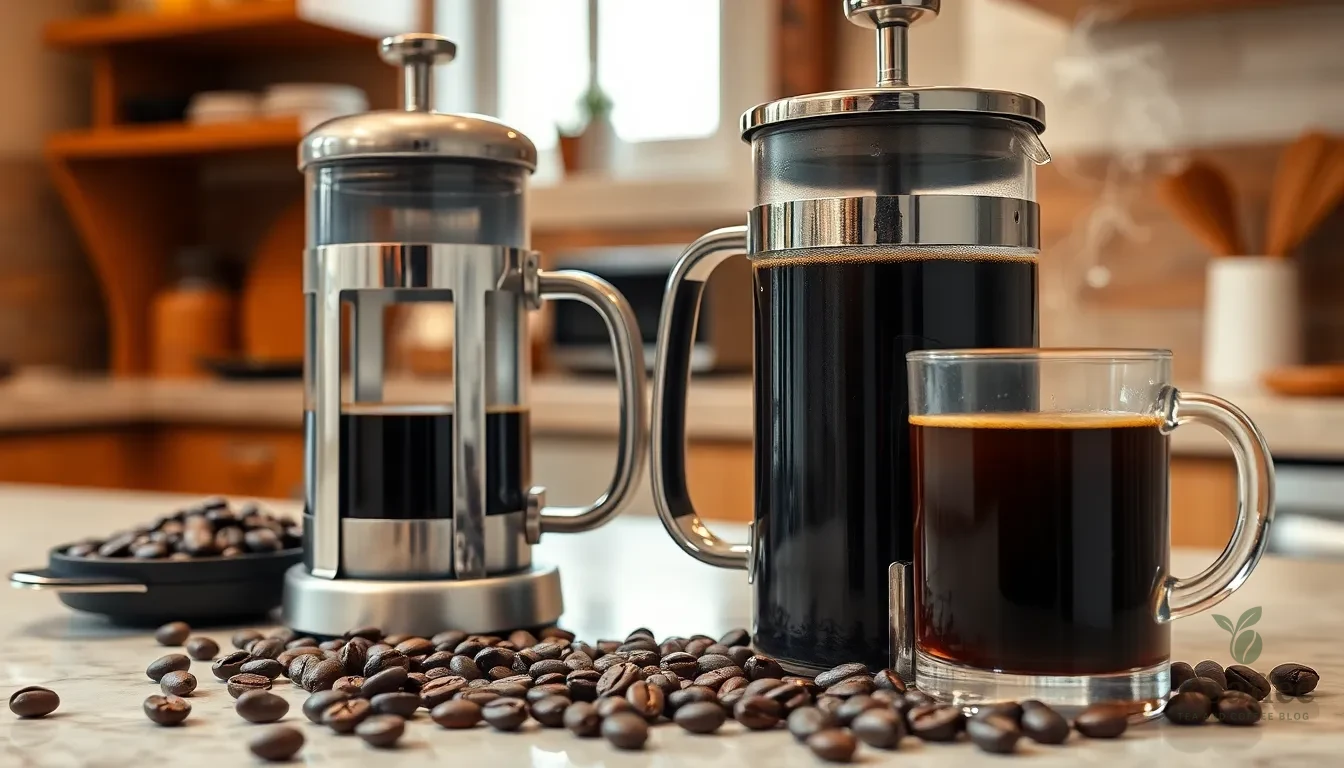
Creating exceptional French press coffee requires just two simple ingredients, though the quality of each component significantly impacts your final brew.
Coffee Beans:
- 30 grams of medium-dark to dark roasted coffee beans
- Coarsely ground (similar to coarse salt or steel-cut oats texture)
- Fresh beans roasted within 2-4 weeks for optimal flavor
Water:
- 500 ml of filtered water
- Heated to 80-90°C (180-194°F)
- Quality filtered water enhances coffee clarity and taste
| Component | Amount | Temperature | Notes |
|---|---|---|---|
| Coffee Beans | 30g | Room temperature | Medium-dark to dark roast |
| Water | 500ml | 80-90°C (180-194°F) | Filtered preferred |
| Ratio | 1:16 | – | Coffee to water ratio |
We recommend using medium-dark to dark roasted beans because they enhance the bold character that French press brewing naturally produces. The coarse grind size prevents over-extraction and reduces sediment in your cup. Fresh filtered water eliminates chlorine and mineral flavors that can interfere with coffee’s natural taste profile.
Our preferred coffee-to-water ratio of 1:16 creates a balanced brew that showcases the beans’ full flavor without overwhelming bitterness. You can adjust this ratio based on your taste preferences, using slightly more coffee for a stronger brew or less for a milder cup.
Instructions
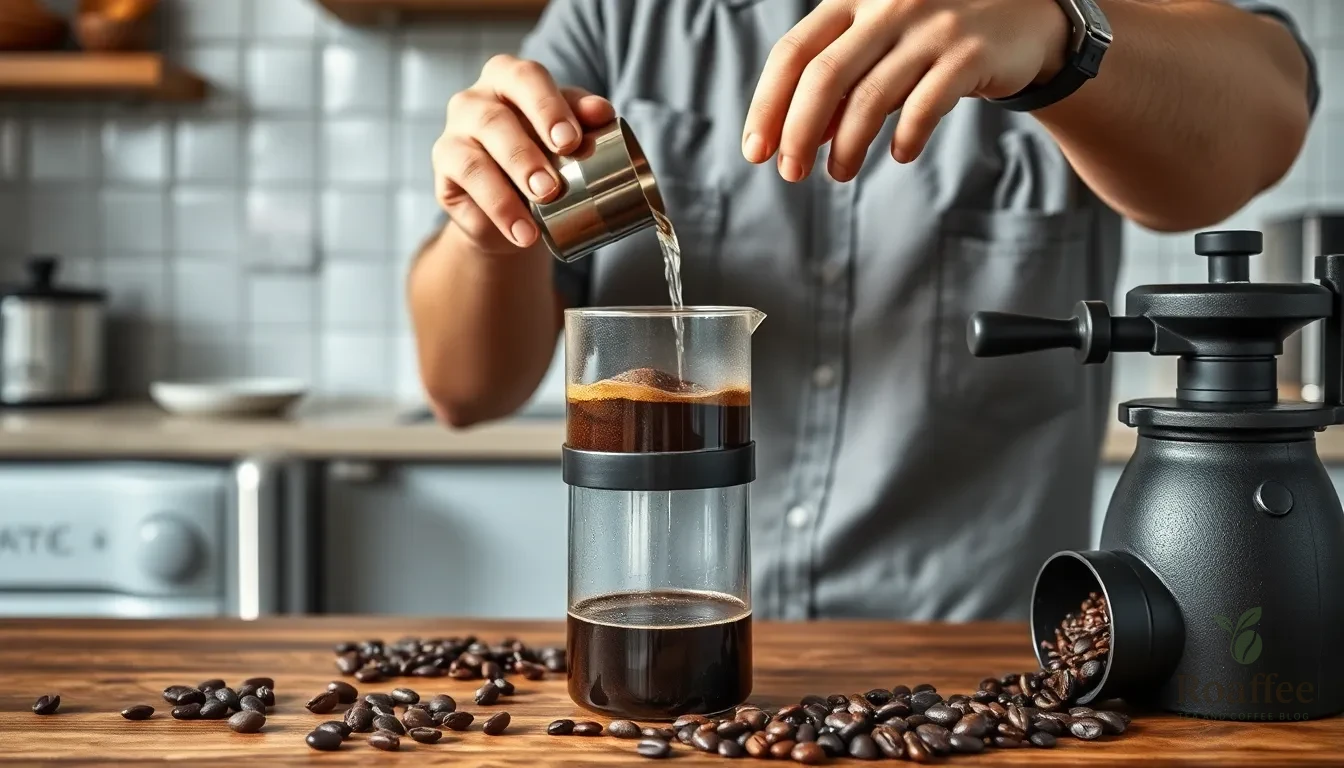
Now that we have our equipment and ingredients ready, let’s walk through the brewing process step by step. Following these instructions will help us create a rich and flavorful French press coffee every time.
Prep the Coffee
We begin by grinding our coffee beans to a very coarse consistency that resembles coarse salt or breadcrumbs. This grind size prevents over-extraction and reduces bitterness in our final cup. Using a burr grinder ensures we get uniform particle size for even extraction.
We measure approximately 30 grams of coffee grounds for our standard French press. The coarse grind allows water to flow through easily while still extracting the essential oils and flavors that make French press coffee so distinctive.
Heat the Water
We bring our filtered water to a boil and then let it cool slightly to reach the optimal temperature of 200-205°F. This temperature range sits just off the boiling point and provides the best extraction without scorching the coffee grounds. For dark roasts or decaf varieties, we reduce the temperature by 10-15°F for better results.
Before adding our coffee, we warm the French press by rinsing it with hot water. This step helps stabilize the brewing temperature and ensures consistent extraction throughout the steeping process.
Add Coffee Grounds
We place our coarse coffee grounds into the warmed French press, distributing them evenly across the bottom. Next, we pour approximately half of our hot water over the grounds to initiate the bloom phase. This process allows trapped gases to escape and enhances both flavor and aroma development.
The bloom creates a beautiful crust of grounds on the surface as carbon dioxide releases from the freshly ground coffee. We watch for this natural reaction as an indicator that our coffee is fresh and ready for optimal extraction.
Pour and Steep
After about 30 seconds, we gently stir the coffee with our wooden spoon to break up the crust and ensure even mixing of grounds with water. We pour the remaining hot water to fill the French press completely and place the lid with the plunger pulled up.
We set our timer for exactly 4 minutes to achieve the perfect steeping time. During this crucial period, the water extracts oils, acids, and flavor compounds from the coffee grounds. The extended contact time creates the full-bodied character that makes French press coffee unique.
Press and Serve
We slowly press the plunger down with firm, steady pressure to separate the coffee grounds from the liquid. The metal filter traps the grounds at the bottom while allowing the extracted coffee to flow through. We avoid pressing too quickly to prevent grounds from escaping into our brew.
Immediately after pressing, we pour the coffee into our cups or transfer it to a carafe. This prevents over-extraction and bitterness that occurs when coffee sits too long with the grounds. Our French press coffee is now ready to enjoy with its rich, full-bodied flavor and aromatic qualities.
Directions for Perfect Brewing
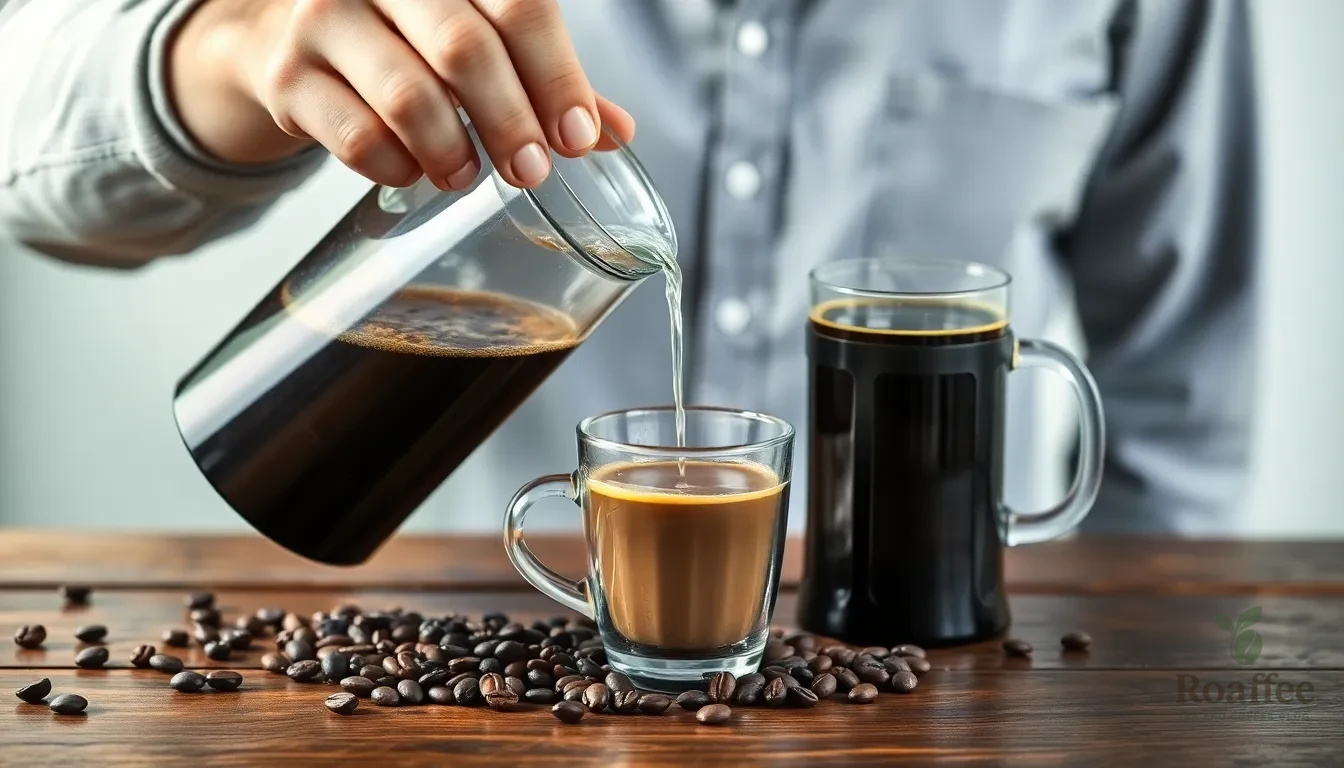
Now that we’ve covered the essential ingredients and preparation steps, let’s jump into the critical brewing parameters that will elevate your French press coffee from good to exceptional. These precise guidelines ensure consistent results every time you brew.
Water Temperature Guidelines
We recommend heating your water to 200°F to 205°F for optimal extraction without scorching the coffee grounds. This temperature range sits just below boiling point and allows the water to extract the full spectrum of flavors from your beans without creating bitter compounds.
| Temperature Range | Method | Result |
|---|---|---|
| 200°F – 205°F | Boil water then cool for 30 seconds | Optimal flavor extraction |
| Below 200°F | Water not hot enough | Under-extracted weak coffee |
| Above 205°F | Water too hot | Over-extracted bitter coffee |
The easiest way to achieve this temperature is to bring your water to a rolling boil then let it cool for approximately 30 seconds. This simple technique consistently delivers water within our target range without requiring a thermometer.
Steeping Time Recommendations
We’ve found that 4 minutes provides the perfect balance of strength and clarity for most coffee preferences. But, you can adjust this timeframe between 4 to 6 minutes depending on your desired intensity and the exact characteristics of your beans.
| Steeping Time | Flavor Profile | Best For |
|---|---|---|
| 4 minutes | Balanced and smooth | Most coffee types |
| 5 minutes | Fuller body and strength | Light roasts |
| 6 minutes | Maximum extraction | Personal preference for strong coffee |
During the initial 30 seconds to 1 minute, we allow the coffee to bloom after adding the first portion of water. This blooming period lets CO2 escape from the grounds and enhances the overall flavor development. We recommend stirring gently during the steeping process but avoid agitation during the final minute to prevent sediment disturbance.
Pressing Technique
We press the plunger slowly and steadily to maintain control and prevent grounds from escaping through the mesh filter. This deliberate movement takes approximately 20 to 30 seconds and requires consistent downward pressure without forcing the mechanism.
The key is stopping the plunger about half an inch above the settled coffee grounds layer. This technique prevents pushing fine particles through the filter while ensuring maximum separation between the liquid and grounds. We avoid rapid or jerky movements that can agitate the sediment and create a cloudy final product.
Once we complete the pressing motion, we pour the coffee immediately into serving mugs. This immediate transfer prevents over-extraction that occurs when the coffee continues to contact the grounds at the bottom of the press.
Tips for the Best French Press Coffee
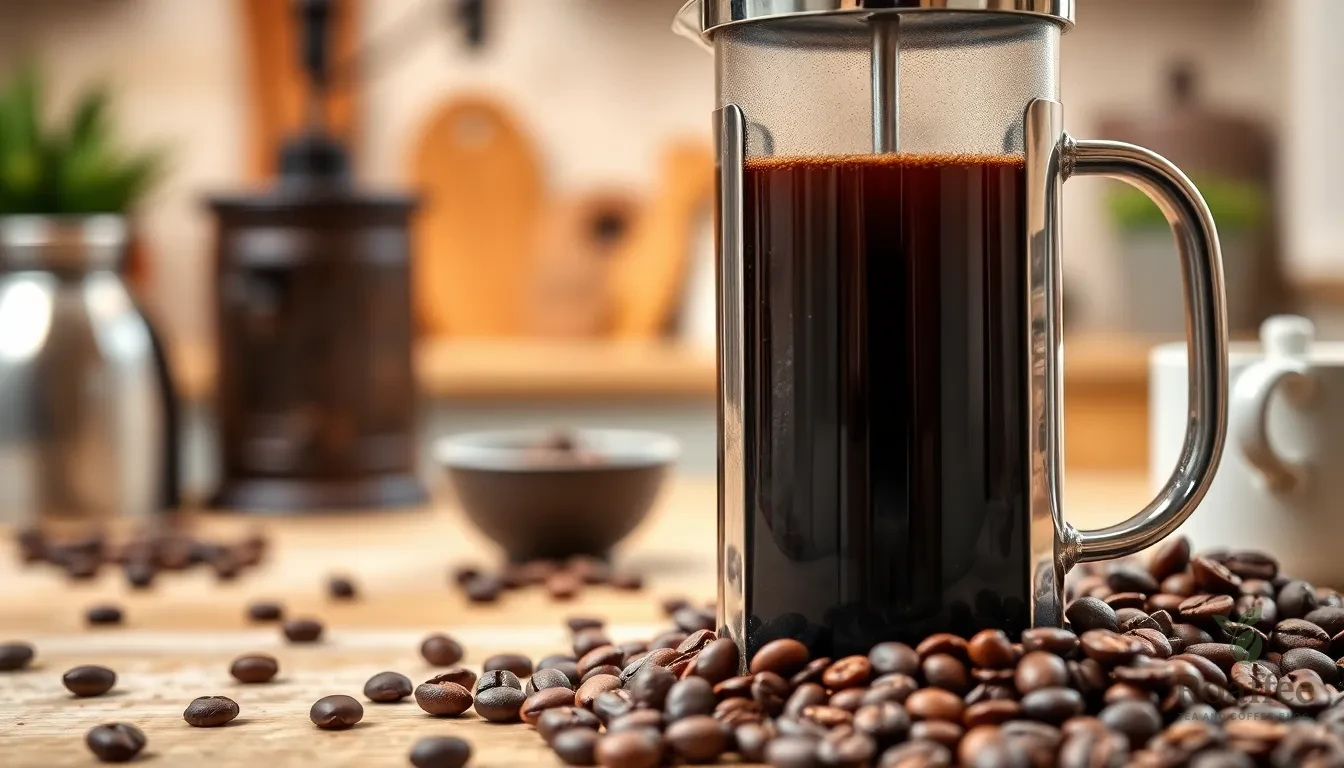
Mastering these essential tips will transform your French press coffee from good to exceptional. We’ve gathered the most crucial elements that make the difference between a mediocre cup and coffee shop quality results.
Choosing the Right Coffee Beans
We always start with fresh, whole coffee beans that have been roasted recently for maximum flavor impact. Whole beans preserve their freshness significantly better than pre-ground coffee, which loses its aromatic oils within hours of grinding. Medium to dark roast coffee beans work exceptionally well for French press brewing because they deliver the rich, full-bodied flavor that complements this brewing method.
When selecting beans, we look for roast dates within 2-4 weeks of purchase. Fresh beans contain more volatile compounds that create the complex flavors we love in French press coffee. Single-origin beans offer unique flavor profiles, while blends provide consistent taste experiences that many coffee drinkers prefer.
Grinding Your Coffee
We use a coarse grind that resembles coarse salt or breadcrumbs for optimal extraction. A burr grinder produces the most consistent particle size, which ensures even extraction and prevents bitter notes from developing. Blade grinders create uneven particles that can lead to over-extraction of smaller pieces and under-extraction of larger ones.
Timing matters significantly when grinding coffee beans. We grind our beans immediately before brewing to preserve the maximum amount of aromatic compounds. Fine grounds will clog the French press filter and create excessive bitterness, while too-coarse grounds result in weak, under-extracted coffee. The ideal grind size allows water to flow through the grounds easily while maintaining proper contact time.
Water Quality Matters
We use clean, filtered water because it directly impacts the final flavor of our coffee. Water quality affects extraction efficiency and can introduce unwanted flavors that mask the coffee’s natural characteristics. Municipal water often contains chlorine and other chemicals that interfere with proper extraction.
The water temperature we target is 200°F to 205°F, which sits just off the boiling point. This temperature range extracts the optimal amount of soluble compounds without burning the grounds. We preheat our French press by rinsing it with hot water, which helps maintain the brewing temperature throughout the steeping process and ensures consistent extraction.
| Water Parameter | Optimal Range | Impact on Flavor |
|---|---|---|
| Temperature | 200°F – 205°F | Proper extraction without burning |
| TDS (Total Dissolved Solids) | 150-300 ppm | Balanced mineral content |
| pH Level | 6.5-7.5 | Neutral to slightly acidic |
Troubleshooting Common Issues
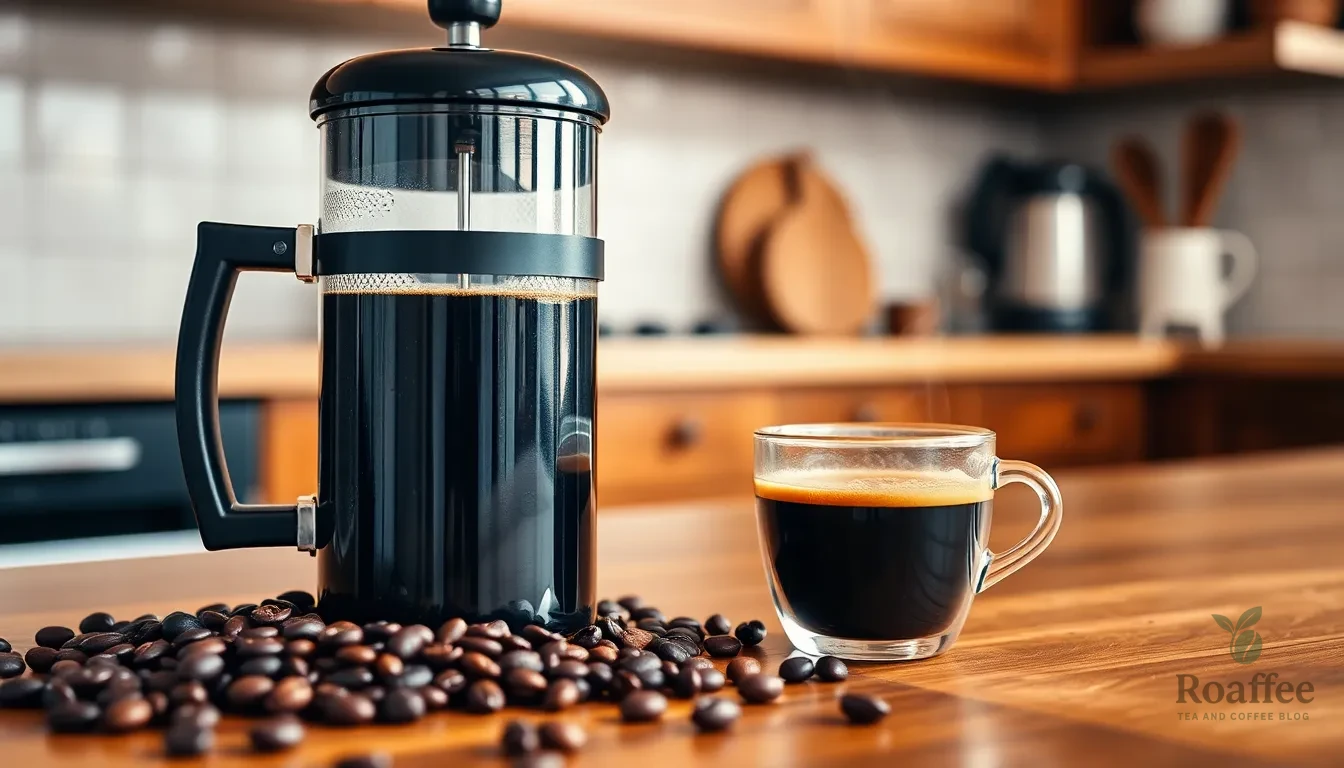
Even experienced coffee enthusiasts encounter challenges when brewing French press coffee. We’ll address the most common problems and provide practical answers to ensure your next cup meets your expectations.
Coffee Too Weak or Strong
Weak coffee typically results from an incorrect coffee-to-water ratio or insufficient extraction time. We recommend using more coffee grounds to strengthen your brew, maintaining the proper ratio of approximately 1:15 coffee to water by weight. Adjusting your grind size slightly finer can also improve extraction without creating sediment issues.
Strong or bitter coffee often indicates over-extraction or an excessive coffee-to-water ratio. Reduce the amount of coffee grounds you use or shorten the steeping time from our recommended 4 minutes. Over-extraction occurs when coffee sits too long after pressing, so pour your coffee immediately once you’ve pressed the plunger down.
| Issue | Primary Cause | Solution |
|---|---|---|
| Coffee Too Weak | Low coffee-to-water ratio | Use more coffee grounds; maintain 1:15 ratio |
| Coffee Too Strong | High coffee-to-water ratio or over-extraction | Use less coffee or shorten steep time |
| Bitter Coffee | Over-extraction from extended steeping | Steep for 4 minutes maximum; pour immediately |
| Sour or Weak Taste | Under-extraction or low water temperature | Increase steep time or water temperature |
Grounds in Your Cup
Coffee grounds in your cup indicate either too fine a grind or improper pressing technique. Use coarse coffee grounds that resemble breadcrumbs rather than fine powder. Fine grounds slip through the mesh filter and create an unpleasant drinking experience.
Pressing the plunger too quickly forces grounds through the filter mesh. Apply steady, even pressure when pressing down, taking approximately 30 seconds to complete the motion. This controlled approach prevents grounds from escaping while maintaining proper filtration.
Temperature Problems
Water temperature significantly impacts extraction quality and flavor development. We recommend heating water to 200-205°F (93-96°C) for optimal results. Water that’s too hot extracts bitter compounds, while water that’s too cool results in weak, under-extracted coffee.
Different roast levels require slight temperature adjustments for best results. Use slightly cooler water around 195°F for dark roasts to prevent over-extraction of bitter compounds. Light roasts benefit from hotter water closer to 205°F to fully extract their complex flavors. Quality water that tastes clean directly affects your coffee’s final flavor since water comprises over 98% of your finished brew.
Cleaning and Maintenance
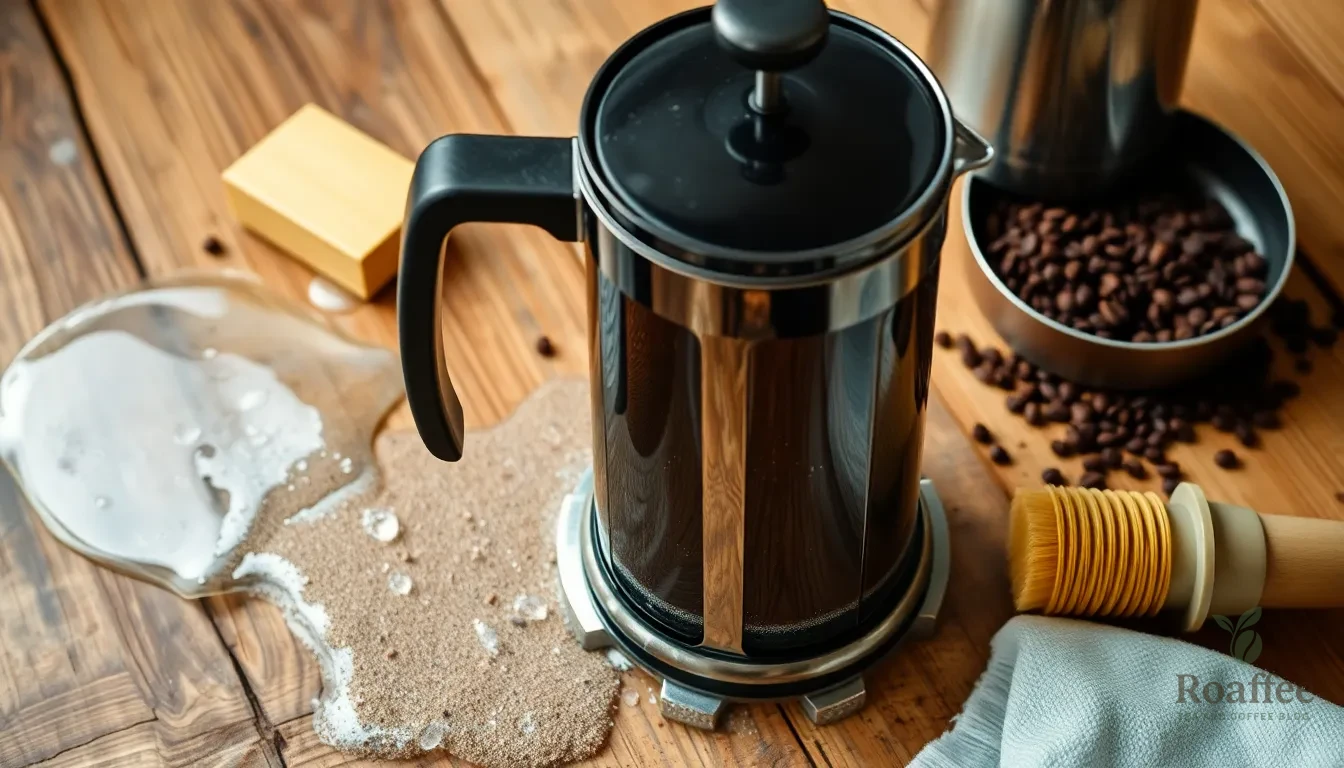
Proper maintenance preserves your French press’s performance and ensures each cup delivers optimal flavor. Regular cleaning prevents coffee oils and residue from creating bitter tastes that can overpower your carefully brewed coffee.
Daily Cleaning Steps
We recommend completing these essential cleaning steps after each brewing session to maintain your French press in peak condition.
Remove Coffee Grounds: Empty all coffee grounds into your trash or compost bin immediately after pressing. Never dispose of grounds down your sink drain as they can cause serious clogs.
Disassemble the Plunger: Take apart the plunger mechanism by removing the filter screens and separating all components. This allows thorough cleaning of each part.
Rinse with Warm Water: Flush all parts under warm running water to remove loose grounds and surface oils. Pay special attention to the mesh filter where particles commonly accumulate.
Soapy Water Plunge: Fill the carafe with warm soapy water and reassemble the plunger. Plunge the filter several times through the soapy water to clean the mesh thoroughly and dislodge trapped particles.
Final Rinse and Dry: Rinse all components again under warm water to eliminate soap residue. Air dry completely or use a lint-free cloth to prevent water spots and maintain the press’s appearance.
Deep Cleaning Your French Press
We suggest performing this comprehensive cleaning weekly to remove stubborn coffee oils and maintain optimal brewing conditions.
Complete Disassembly: Remove every component including the plunger rod, filter screens, and any removable parts. This ensures access to all surfaces where oils can accumulate.
Scrub All Components: Use warm soapy water with a soft brush to scrub each part thoroughly. Focus on removing any visible coffee residue and oils that can cause bitter flavors in future brews.
Rinse and Inspect: Rinse all parts under warm water and inspect for any remaining buildup. Repeat scrubbing if necessary to achieve complete cleanliness.
Dry and Reassemble: Allow all components to air dry completely before reassembling your French press. This prevents moisture from creating bacterial growth and maintains the integrity of your brewing equipment.
Regular maintenance following these steps prolongs your French press’s lifespan while ensuring pure coffee flavor in every cup.
Storage and Make-Ahead Tips
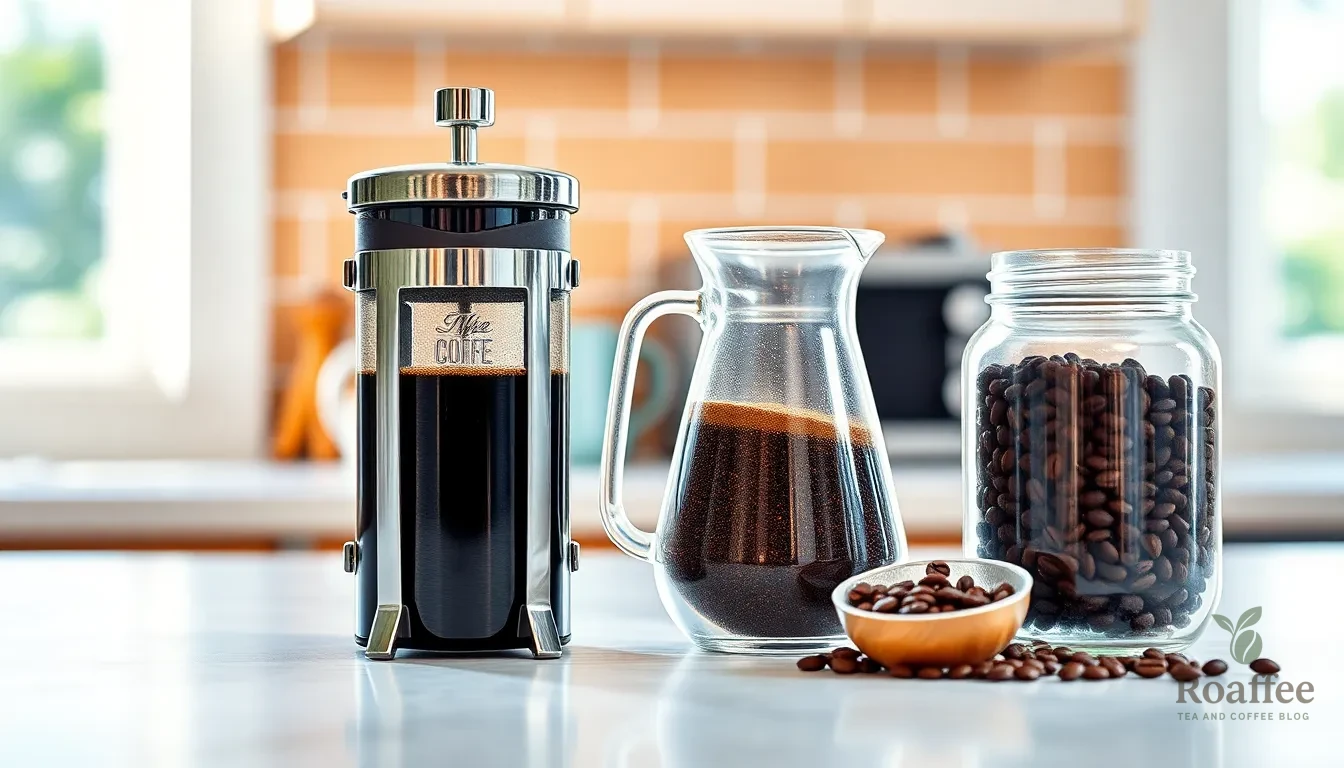
French press coffee tastes best when we enjoy it immediately after brewing for optimal freshness and flavor. We must transfer the coffee promptly to a thermal carafe if we need to store it temporarily. This method keeps our coffee warm without allowing it to become bitter from continued extraction.
Leaving coffee sitting on the grounds creates a major problem we want to avoid. The extraction process continues even after pressing the plunger down. This ongoing contact between coffee and grounds produces an increasingly bitter taste that ruins our carefully crafted brew.
We can prepare coffee grounds ahead of time to streamline our morning routine. But whole beans maintain their freshness significantly longer than pre-ground coffee. When we do grind beans in advance we should store the grounds in an airtight container placed in a cool dark location.
| Storage Method | Freshness Duration | Quality Impact |
|---|---|---|
| Brewed coffee (immediate consumption) | Best within 30 minutes | Optimal flavor and aroma |
| Brewed coffee (thermal carafe) | Up to 2 hours | Good flavor retention |
| Pre-ground coffee (airtight container) | 1-2 weeks | Moderate flavor loss |
| Whole beans (proper storage) | 2-4 weeks | Maximum flavor preservation |
The key to maintaining quality lies in understanding extraction timing. We should pour our finished coffee immediately after pressing to prevent over-extraction. Any coffee left in the French press with the grounds will continue to extract compounds that create unpleasant bitterness.
Our best strategy involves grinding fresh beans each morning when possible. This approach ensures we capture the full range of flavors and aromas that make French press coffee exceptional. When time constraints require advance preparation we recommend grinding only what we need for the next day or two.
Temperature control becomes crucial when storing brewed coffee. We should avoid reheating coffee as this process damages the delicate flavor compounds we worked to extract properly. Instead thermal carafes or insulated containers help maintain the ideal serving temperature without compromising taste.
Conclusion
We’ve walked you through everything you need to know about making exceptional French press coffee at home. From selecting the right equipment and fresh beans to mastering the brewing technique and troubleshooting common issues you’re now equipped with the knowledge to create café-quality coffee every morning.
Remember that consistency is key – stick to the 1:15 coffee-to-water ratio maintain your water temperature between 200-205°F and don’t skip the 4-minute steeping time. These fundamentals will serve as your foundation for great coffee.
The beauty of French press brewing lies in its simplicity and the rich full-bodied results it delivers. With proper cleaning and maintenance your French press will continue producing delicious coffee for years to come. Now it’s time to put these techniques into practice and enjoy the perfect cup you’ve been craving.
Frequently Asked Questions
What is the ideal coffee-to-water ratio for French press coffee?
The recommended coffee-to-water ratio is 1:15 to 1:16 for a balanced brew. This typically means using 30 grams of coarsely ground coffee beans with 500ml of filtered water. You can adjust this ratio based on your personal taste preferences – use more coffee for a stronger brew or less for a milder cup.
How long should I steep French press coffee?
French press coffee should steep for exactly 4 minutes for optimal extraction. This timing allows the coffee grounds to fully release their flavors without over-extracting, which can lead to bitterness. Use a timer to ensure consistency in your brewing process.
What water temperature is best for French press brewing?
Heat your water to 200-205°F (93-96°C) for optimal extraction. Water that’s too hot can over-extract the coffee and create bitterness, while water that’s too cool won’t extract enough flavor. If you don’t have a thermometer, bring water to a boil and let it cool for about 30 seconds.
Why is grind size important for French press coffee?
A coarse grind is essential for French press brewing because it prevents over-extraction and reduces sediment in your cup. Fine grounds will slip through the metal filter and create a muddy, bitter coffee. The coarse grind allows for proper extraction during the 4-minute steeping time.
How do I prevent grounds from getting into my coffee?
Use a consistent coarse grind and press the plunger down slowly and steadily. Don’t force or pump the plunger, as this can disturb the coffee bed and push grounds through the filter. Also, ensure your French press filter is clean and in good condition.
How should I clean my French press?
Clean your French press daily by disassembling all parts, rinsing with warm water, and washing with soapy water. Perform a deep clean weekly by scrubbing all components to remove coffee oils. Always dry thoroughly before reassembling to prevent bacterial growth and maintain optimal flavor.
Can I make French press coffee ahead of time?
French press coffee tastes best when consumed immediately after brewing. If you need to store it, transfer the brewed coffee to a thermal carafe to maintain warmth without continued extraction. Avoid leaving coffee sitting on the grounds, as this leads to over-extraction and bitterness.
What type of coffee beans work best for French press?
Use fresh, whole coffee beans roasted within 2-4 weeks for maximum flavor. Medium-dark to dark roasts work particularly well with French press brewing, as they complement the full-bodied brewing method. Always grind beans just before brewing for the best taste.
Why is my French press coffee bitter?
Bitter French press coffee is usually caused by over-extraction from water that’s too hot, steeping too long, or using too fine a grind. Check your water temperature (should be 200-205°F), stick to a 4-minute steep time, and ensure you’re using a coarse grind.
What equipment do I need for French press coffee?
You’ll need a glass or stainless steel French press, a burr grinder for consistent coarse grounds, a digital scale for precise measurements, and a timer. A wooden spoon for stirring and a kettle for heating water complete the basic setup for brewing excellent French press coffee.
